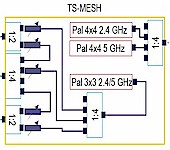
Read on SmallNetBuilder

I'm unclear on your question. Our standard test client is now octoScope's Pal device. You can use anything you want as a client device. But your results will not correlate with ours.1.According to your article , we know that v10 have replaced the Client M600 to PALs. If we try to used NETGEAR R7800 switch to client mode to instead the PALs setting , is that available? (NOTE: R7800 got the same solution with PALs)
Wired router test process is described separately.2. According to How We Test: SmallNetBuilder's Wireless Testbed - Revision 10 ,paragraph "Computer", which said "we've reassigned the two Dell Optiplex SFF machines to wired router test duties ", what's that supposed to mean? That is, You set two Dell PCs for server (same subnet ex. Server1: 192.168.15.7 , Server2: 192.168.15.8), and connected to correspond ip address (like 192.168.15.7 to 192.168.15.9 ) ? Please let us clarify the setting if there has a block diagram, thanks.
I'm unclear on your question. Our standard test client is now octoScope's Pal device. You can use anything you want as a client device. But your results will not correlate with ours.
Wired router test process is described separately.
https://www.smallnetbuilder.com/lanwan/lanwan-howto/33107-how-we-test-hardware-routers-revision-10
Huh?Can we do away from the ping test through a saturated router? That is just a QOS setting to give ping higher priority. We don't want to support DDOS attacks. In the old days telnet needed higher priority so if something went down we could still get into the device to work on it. Now days not so important as we move to web based. Old command line as in Cisco's IOS it is still important. But that is not tested here.
So you don't want me to test for bufferbloat anymore? Or you want a different method used?Your buffer bloat test. Where you ping through a saturated router.
So you don't want me to test for bufferbloat anymore? Or you want a different method used?

Welcome To SNBForums
SNBForums is a community for anyone who wants to learn about or discuss the latest in wireless routers, network storage and the ins and outs of building and maintaining a small network.
If you'd like to post a question, simply register and have at it!
While you're at it, please check out SmallNetBuilder for product reviews and our famous Router Charts, Ranker and plenty more!
